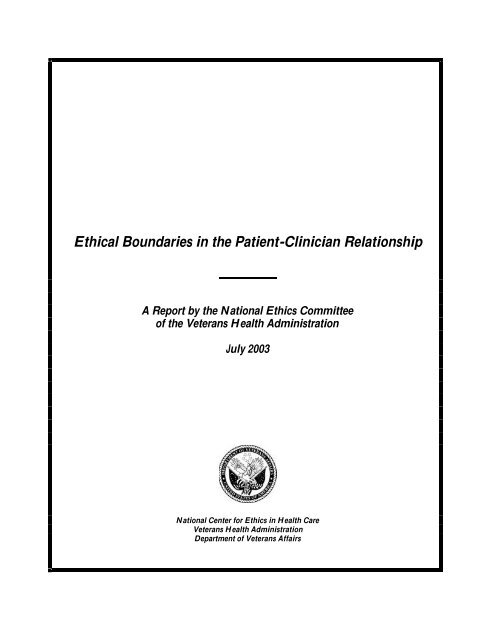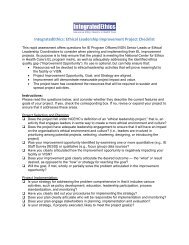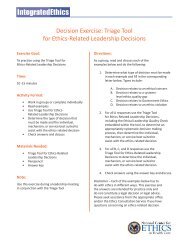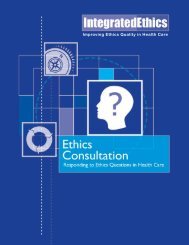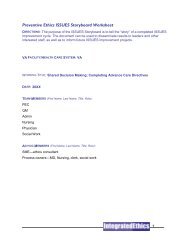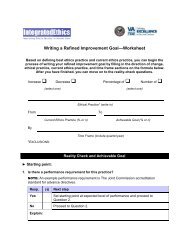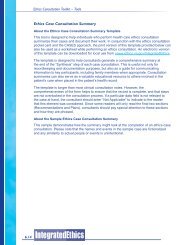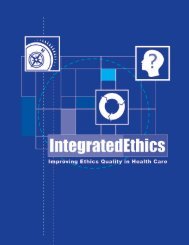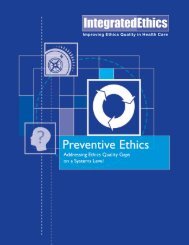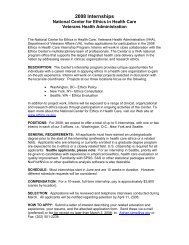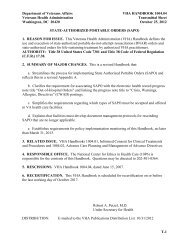Ethical Boundaries in the Patient-Clinician Relationship - NEC ...
Ethical Boundaries in the Patient-Clinician Relationship - NEC ...
Ethical Boundaries in the Patient-Clinician Relationship - NEC ...
You also want an ePaper? Increase the reach of your titles
YUMPU automatically turns print PDFs into web optimized ePapers that Google loves.
<strong>Ethical</strong> <strong>Boundaries</strong> <strong>in</strong> <strong>the</strong> <strong>Patient</strong>-Cl<strong>in</strong>ician <strong>Relationship</strong><br />
A Report by <strong>the</strong> National Ethics Committee<br />
of <strong>the</strong> Veterans Health Adm<strong>in</strong>istration<br />
July 2003<br />
National Center for Ethics <strong>in</strong> Health Care<br />
Veterans Health Adm<strong>in</strong>istration<br />
Department of Veterans Affairs
Founded <strong>in</strong> 1986, <strong>the</strong> National Ethics Committee (<strong>NEC</strong>) of <strong>the</strong> Veterans Health Adm<strong>in</strong>istration<br />
(VHA) is an <strong>in</strong>terdiscipl<strong>in</strong>ary group authorized by <strong>the</strong> Under Secretary for Health through <strong>the</strong><br />
National Center for Ethics <strong>in</strong> Health Care. The <strong>NEC</strong> produces reports on timely topics that are of<br />
significant concern to practic<strong>in</strong>g health care professionals. Each report describes an ethical issue,<br />
summarizes its historical context, discusses its relevance to VHA, reviews current controversies, and<br />
outl<strong>in</strong>es practical recommendations. Previous reports have been useful to VHA professionals as<br />
resources for educational programs, guides for patient care practices, and catalysts for health policy<br />
reform. Scholarly yet practical, <strong>the</strong>se reports are <strong>in</strong>tended to heighten awareness of ethical issues and<br />
to improve <strong>the</strong> quality of health care, both with<strong>in</strong> and beyond VHA.
______________________________________________________________________________________________<br />
<strong>Ethical</strong> <strong>Boundaries</strong> <strong>in</strong> <strong>the</strong> <strong>Patient</strong>-Cl<strong>in</strong>ician <strong>Relationship</strong><br />
Executive Summary<br />
Health care professionals are committed to promot<strong>in</strong>g <strong>the</strong> welfare and well-be<strong>in</strong>g of <strong>the</strong> patient<br />
over and above any personal consideration. Indeed, this fiduciary obligation is one of <strong>the</strong> def<strong>in</strong><strong>in</strong>g<br />
characteristics of a “profession” as such. This concept of a profession gives rise to <strong>the</strong> notion of<br />
boundaries <strong>in</strong> client-professional relationships—that is, to <strong>the</strong> notion that <strong>the</strong>re are limits of ethically<br />
appropriate professional behavior.<br />
A boundary violation occurs when a health care professional’s behavior goes beyond appropriate<br />
professional limits. Boundary violations generally arise when a personal <strong>in</strong>terest displaces <strong>the</strong><br />
professional’s primary commitment to <strong>the</strong> patient’s welfare <strong>in</strong> ways that harm <strong>the</strong> patient or <strong>the</strong><br />
patient-cl<strong>in</strong>ician relationship. Interactions between health care professionals and patients are<br />
ethically problematic when <strong>the</strong>y can reasonably be expected to affect <strong>the</strong> care <strong>the</strong> <strong>in</strong>dividual or o<strong>the</strong>r<br />
patients receive or <strong>the</strong> health care professional’s relationships with colleagues—or when <strong>the</strong>y give<br />
<strong>the</strong> appearance of do<strong>in</strong>g so.<br />
This report by <strong>the</strong> VHA National Ethics Committee exam<strong>in</strong>es <strong>the</strong> concept of professionalism <strong>in</strong><br />
health care and <strong>the</strong> role-based obligations of health care professionals <strong>in</strong> <strong>the</strong>ir relationships with<br />
patients, clarifies <strong>the</strong> concept of boundaries and boundary violations, and analyzes examples of<br />
potentially problematic actions to help cl<strong>in</strong>icians identify and avoid professionally <strong>in</strong>appropriate<br />
conduct. The report recommends that health care professionals:<br />
(1) Critically exam<strong>in</strong>e <strong>the</strong>ir own actions by ask<strong>in</strong>g <strong>the</strong>mselves <strong>the</strong> follow<strong>in</strong>g questions:<br />
v Is this activity a normal, expected part of practice for members of my<br />
profession?<br />
v Might engag<strong>in</strong>g <strong>in</strong> this activity compromise my relationship with this patient?<br />
With o<strong>the</strong>r patients? With my colleagues? With my <strong>in</strong>stitution? With <strong>the</strong> public?<br />
v Could this activity cause o<strong>the</strong>rs to question my professional objectivity?<br />
v Would I want my o<strong>the</strong>r patients, o<strong>the</strong>r professionals, or <strong>the</strong> public to know that I<br />
engage <strong>in</strong> such activities?<br />
(2) Take appropriate action if <strong>the</strong> answers to <strong>the</strong>se questions <strong>in</strong>dicate that an activity may violate<br />
professional ethical boundaries:<br />
v Determ<strong>in</strong>e if <strong>the</strong>re are applicable standards.<br />
v Consult a trusted and objective peer for a second op<strong>in</strong>ion about <strong>the</strong> activity.<br />
v Seek assistance from a supervisor or ethics committee.<br />
v Communicate his or her concern to <strong>the</strong> <strong>in</strong>dividual <strong>in</strong>volved.<br />
v Transfer <strong>the</strong> patient to ano<strong>the</strong>r cl<strong>in</strong>ician’s care if <strong>the</strong> professional relationship has<br />
been compromised, or if avoid<strong>in</strong>g <strong>the</strong> violation will damage <strong>the</strong> relationship.<br />
(3) Be familiar with:<br />
v Relevant professional codes of ethics, standards of practice, guidel<strong>in</strong>es, and<br />
position statements;<br />
v Applicable policies <strong>in</strong> <strong>the</strong>ir facilities;<br />
and<br />
v Laws perta<strong>in</strong><strong>in</strong>g to relationships between patients and health care professionals.<br />
National Center for Ethics <strong>in</strong> Health Care, July 2003 1
______________________________________________________________________________________________<br />
<strong>Ethical</strong> <strong>Boundaries</strong> <strong>in</strong> <strong>the</strong> <strong>Patient</strong>-Cl<strong>in</strong>ician <strong>Relationship</strong><br />
Introduction<br />
<strong>Boundaries</strong> def<strong>in</strong>e <strong>the</strong> limits of appropriate behavior by a professional toward his or her clients.<br />
By establish<strong>in</strong>g boundaries, a health care professional creates a safe space for <strong>the</strong> <strong>the</strong>rapeutic<br />
relationship to occur. Concerns about professional boundaries <strong>in</strong> <strong>the</strong> relationship between patients<br />
and health care providers—and <strong>the</strong> damage that results when boundaries are transgressed—captured<br />
public and professional attention follow<strong>in</strong>g reports of <strong>in</strong>appropriate sexual relationships between<br />
health care professionals and patients. 1-5 Relatively little attention has been paid to <strong>the</strong> “boundary<br />
question” outside this context, 4-8 but many o<strong>the</strong>r <strong>in</strong>teractions raise concerns about boundaries as<br />
well. Health care professionals need guidance if <strong>the</strong>y are to avoid engag<strong>in</strong>g <strong>in</strong> <strong>in</strong>teractions with <strong>the</strong>ir<br />
patients that may prove ethically problematic.<br />
Professionalism <strong>in</strong> Health Care<br />
The notion of boundaries <strong>in</strong> <strong>the</strong> health care sett<strong>in</strong>g is rooted <strong>in</strong> <strong>the</strong> concept of a “profession.”<br />
While this concept is understood <strong>in</strong> several different ways <strong>in</strong> <strong>the</strong> medical and sociological literature,<br />
<strong>the</strong>re is consensus regard<strong>in</strong>g one of <strong>the</strong> def<strong>in</strong><strong>in</strong>g characteristics of professions and professionals:<br />
commitment to serve <strong>the</strong> profession’s clients. 9 That is, professionals are expected to make a<br />
fiduciary commitment to place <strong>the</strong>ir clients’ <strong>in</strong>terests ahead of <strong>the</strong>ir own. In exchange for faithfully<br />
apply<strong>in</strong>g <strong>the</strong>ir unique knowledge and skills on behalf of <strong>the</strong>ir clients, members of a profession are<br />
granted <strong>the</strong> freedom to practice and to regulate <strong>the</strong>mselves. 10-12<br />
Thus for physicians:<br />
Professionalism is <strong>the</strong> basis of medic<strong>in</strong>e’s contract with society. It demands plac<strong>in</strong>g <strong>the</strong> <strong>in</strong>terests<br />
of patients above those of <strong>the</strong> physician, sett<strong>in</strong>g and ma<strong>in</strong>ta<strong>in</strong><strong>in</strong>g standards of<br />
competence and <strong>in</strong>tegrity, and provid<strong>in</strong>g expert advice to society on matters of<br />
health. The pr<strong>in</strong>ciples and responsibilities of medical professionalism must be clearly<br />
understood by both <strong>the</strong> profession and society. Essential to this contract is public<br />
trust <strong>in</strong> physicians, which depends on <strong>the</strong> <strong>in</strong>tegrity of both <strong>in</strong>dividual physicians and<br />
<strong>the</strong> whole profession. 13 (orig<strong>in</strong>al italics)<br />
<strong>Patient</strong>s who come to health care professionals when <strong>the</strong>y are ill and vulnerable br<strong>in</strong>g with <strong>the</strong>m<br />
expectations about this <strong>in</strong>teraction and how cl<strong>in</strong>icians should behave toward <strong>the</strong>m as health care<br />
professionals, though patients are not always able to articulate those expectations clearly. <strong>Patient</strong>s<br />
should be able to trust that <strong>the</strong>ir <strong>in</strong>terests and welfare will be placed above those of <strong>the</strong> health care<br />
professional, just as <strong>the</strong>y should be confident <strong>the</strong>y will be treated with respect, and be <strong>in</strong>formed so<br />
that <strong>the</strong>y can make <strong>the</strong>ir own health care decisions to <strong>the</strong> greatest extent possible.<br />
Professionals, as such, are held to different standards of conduct from o<strong>the</strong>r persons.<br />
<strong>Relationship</strong>s and <strong>in</strong>teractions that may be ethically unproblematic among nonprofessionals may be<br />
unacceptable when one of <strong>the</strong> parties is a professional. An <strong>in</strong>dividual may have a personal <strong>in</strong>terest<br />
that is perfectly acceptable <strong>in</strong> itself, but that conflicts with an obligation <strong>the</strong> same <strong>in</strong>dividual has as a<br />
health care professional. For example, under circumstances <strong>in</strong> which it would normally be acceptable for<br />
one person to ask ano<strong>the</strong>r <strong>in</strong>dividual for a date, it may not be acceptable for a physician or o<strong>the</strong>r<br />
health care professional to ask a patient for a date, because do<strong>in</strong>g so might compromise <strong>the</strong><br />
professional’s fiduciary commitment to <strong>the</strong> patient’s welfare. The nature of professions is such that<br />
“<strong>the</strong> human needs <strong>the</strong> professions address and <strong>the</strong> human relationships peculiar to <strong>the</strong>m ... are<br />
sufficiently dist<strong>in</strong>ct to warrant, <strong>in</strong>deed to demand, expectations of a higher morality and a greater<br />
commitment to <strong>the</strong> good of o<strong>the</strong>rs than <strong>in</strong> most o<strong>the</strong>r human activities.” 14<br />
The cl<strong>in</strong>ical relationship is one of both great <strong>in</strong>timacy and great disparity <strong>in</strong> power and<br />
knowledge, giv<strong>in</strong>g rise to special obligations for health care professionals. The American College of<br />
2 National Center for Ethics <strong>in</strong> Health Care, July 2003
______________________________________________________________________________________________<br />
<strong>Ethical</strong> <strong>Boundaries</strong> <strong>in</strong> <strong>the</strong> <strong>Patient</strong>-Cl<strong>in</strong>ician <strong>Relationship</strong><br />
Physicians def<strong>in</strong>es <strong>the</strong> ethics of <strong>the</strong> patient-physician relationship <strong>in</strong> just <strong>the</strong>se terms:<br />
The patient-physician relationship entails special obligations for <strong>the</strong> physician to serve<br />
<strong>the</strong> patient’s <strong>in</strong>terest because of <strong>the</strong> specialized knowledge that physicians hold and <strong>the</strong><br />
imbalance of power between physicians and patients. 15<br />
The Ethics of Professional <strong>Boundaries</strong><br />
<strong>Boundaries</strong>, it has been said, “def<strong>in</strong>e <strong>the</strong> professional relationship as fundamentally respectful<br />
and protective of <strong>the</strong> patient and as dedicated to <strong>the</strong> patient’s well-be<strong>in</strong>g and best <strong>in</strong>terests. 16 A<br />
boundary violation occurs when a health care professional’s behavior goes beyond appropriate<br />
professional limits. Boundary violations generally arise when <strong>the</strong> <strong>in</strong>teraction between parties blurs<br />
<strong>the</strong>ir roles vis-à-vis one ano<strong>the</strong>r, or creates a “double b<strong>in</strong>d” situation <strong>in</strong> which a personal <strong>in</strong>terest<br />
displaces <strong>the</strong> professional’s primary commitment to <strong>the</strong> patient’s welfare <strong>in</strong> ways that harm—or<br />
appear to harm—<strong>the</strong> patient or <strong>the</strong> patient-cl<strong>in</strong>ician relationship, or might reasonably be expected to<br />
do so. 17-18<br />
The Code of Ethics of <strong>the</strong> American Nurses Association observes:<br />
The <strong>in</strong>timate nature of nurs<strong>in</strong>g care, <strong>the</strong> <strong>in</strong>volvement of nurses [<strong>in</strong>] important and<br />
sometimes highly stressful life events, and <strong>the</strong> mutual dependence of colleagues work<strong>in</strong>g<br />
<strong>in</strong> close concert all present <strong>the</strong> potential for blurr<strong>in</strong>g of limits to professional<br />
relationships. ... [R]ema<strong>in</strong><strong>in</strong>g with<strong>in</strong> <strong>the</strong> bounds established by <strong>the</strong> purpose of <strong>the</strong><br />
relationship can be especially difficult <strong>in</strong> prolonged or long-term relationships. In all<br />
encounters, nurses are responsible for reta<strong>in</strong><strong>in</strong>g <strong>the</strong>ir professional boundaries. 19<br />
A variety of standards establish <strong>the</strong> limits of appropriate professional behavior, whe<strong>the</strong>r those<br />
limits are explicitly enumerated <strong>in</strong> standards of conduct, codes of ethics, or law, or tacitly conveyed<br />
through professional tra<strong>in</strong><strong>in</strong>g and widespread acceptance. Individuals who seek help must rely on<br />
<strong>the</strong> professional <strong>the</strong>y consult to be trustworthy—when cl<strong>in</strong>icians behave <strong>in</strong> ways that call <strong>the</strong>ir<br />
professional judgment and objectivity <strong>in</strong>to question, <strong>the</strong> trust on which <strong>the</strong> relationship depends is<br />
compromised. And when trust is compromised, <strong>the</strong> efficacy of <strong>the</strong> <strong>the</strong>rapeutic relationship is<br />
adversely affected. 20-21<br />
Boundary violations harm not only <strong>in</strong>dividual patients; <strong>the</strong>y carry consequences for o<strong>the</strong>rs when<br />
<strong>the</strong>y erode trust and confidence <strong>in</strong> <strong>the</strong> profession more broadly. As <strong>the</strong> American College of<br />
Physicians Ethics Manual notes, physicians’ obligations to society “parallel <strong>the</strong>ir obligations to<br />
<strong>in</strong>dividual patients. Physicians’ conduct as professionals ... should merit <strong>the</strong> respect of <strong>the</strong><br />
community.” 15 Clear—and scrupulously adhered to—boundaries thus protect health care<br />
professionals as well as patients, help<strong>in</strong>g to susta<strong>in</strong> <strong>the</strong> public trust on which <strong>the</strong> freedom to practice<br />
rests.<br />
It is important to note that personal and professional <strong>in</strong>terests are not <strong>in</strong>herently <strong>in</strong> conflict with<br />
one ano<strong>the</strong>r; <strong>in</strong> fact, <strong>the</strong>y often co<strong>in</strong>cide. A cl<strong>in</strong>ician’s personal desire to be compassionate is<br />
compatible with his or her professional obligations. It is natural to want to earn money through<br />
one’s professional activity. That desire becomes problematic only when <strong>the</strong> personal <strong>in</strong>terest <strong>in</strong><br />
earn<strong>in</strong>g a livelihood <strong>in</strong>terferes with one’s commitments and obligations as a health care professional.<br />
<strong>Ethical</strong>, Legal & Institutional Standards<br />
Standards regard<strong>in</strong>g professional boundaries can be found <strong>in</strong> a variety of sources. Directly or<br />
<strong>in</strong>directly, professional codes of ethics, consensus statements, position papers, policies, and laws<br />
National Center for Ethics <strong>in</strong> Health Care, July 2003 3
______________________________________________________________________________________________<br />
<strong>Ethical</strong> <strong>Boundaries</strong> <strong>in</strong> <strong>the</strong> <strong>Patient</strong>-Cl<strong>in</strong>ician <strong>Relationship</strong><br />
def<strong>in</strong>e <strong>the</strong> boundaries of appropriate behavior for health care professionals. 22 The Medical<br />
Professionalism Project of <strong>the</strong> American Board of Internal Medic<strong>in</strong>e notes, for example, that<br />
medical professionals must exhibit a:<br />
Commitment to ma<strong>in</strong>ta<strong>in</strong><strong>in</strong>g appropriate relations with patients. Given <strong>the</strong> <strong>in</strong>herent<br />
vulnerability and dependency of patients, certa<strong>in</strong> relationships between physicians<br />
and patients must be avoided. In particular, physicians should never exploit patients<br />
for any sexual advantage, personal f<strong>in</strong>ancial ga<strong>in</strong>, or o<strong>the</strong>r private purposes. 13 (orig<strong>in</strong>al<br />
italics)<br />
These various codes, consensus statements, and position papers can assist cl<strong>in</strong>icians to ma<strong>in</strong>ta<strong>in</strong><br />
boundaries <strong>in</strong> <strong>the</strong>ir professional relationships with patients. Some standards are concrete, sett<strong>in</strong>g<br />
specific thresholds for professional behavior, often by proscrib<strong>in</strong>g particular activities or<br />
relationships. For example, <strong>the</strong> Code of Ethics of <strong>the</strong> American Medical Association (AMA)<br />
expressly prohibits “sexual contact with patients that occurs concurrent with <strong>the</strong> physician-patient<br />
relationship.” 23 Similarly, <strong>the</strong> American College of Physicians forbids sexual relationships with<br />
patients and former patients, argu<strong>in</strong>g that “[t]he <strong>in</strong>tense trust often established between physician<br />
and patient may amplify <strong>the</strong> patient’s vulnerability <strong>in</strong> a subsequent sexual relationship.” 15 Often, <strong>the</strong><br />
standards set by professional organizations carry sanctions for professionals who violate acceptable<br />
behavior. Thus, for example, <strong>the</strong> AMA’s Council on <strong>Ethical</strong> and Judicial Affairs has authority to<br />
“censure, suspend or expel an active constituent member from <strong>the</strong> American Medical Association<br />
for an <strong>in</strong>fraction of <strong>the</strong> Constitution or <strong>the</strong>se Bylaws, for a violation of <strong>the</strong> Pr<strong>in</strong>ciples of Medical<br />
Ethics, or for unethical or illegal conduct.” 23<br />
O<strong>the</strong>r standards, however, set out only general values and pr<strong>in</strong>ciples that should guide <strong>the</strong><br />
professional’s conduct and decision mak<strong>in</strong>g, and rely on health care professionals to use good<br />
judgment <strong>in</strong> apply<strong>in</strong>g those values and pr<strong>in</strong>ciples. Thus, for example, <strong>the</strong> National Association of<br />
Social Workers’ Code of Ethics requires that social workers “not engage <strong>in</strong> dual or multiple<br />
relationships with clients or former clients <strong>in</strong> which <strong>the</strong>re is a risk of exploitation or potential harm<br />
to <strong>the</strong> client” and broadly def<strong>in</strong>es “dual or multiple relationships,” but does not suggest criteria by<br />
which professionals should assess <strong>the</strong> nature or level of risk a particular dual relationship would pose<br />
for a client. 24 The message implicitly shared by all such documents, however, is that be<strong>in</strong>g a<br />
professional entails forgo<strong>in</strong>g some <strong>in</strong>teractions or relationships <strong>in</strong> which one might o<strong>the</strong>rwise wish<br />
to engage <strong>in</strong> order to protect <strong>the</strong> <strong>in</strong>terests and well-be<strong>in</strong>g of clients/patients.<br />
In addition to professional codes of ethics, various legal and regulatory requirements address<br />
boundaries <strong>in</strong> patient-professional <strong>in</strong>teractions. ∗ As employees of <strong>the</strong> federal government, all VHA<br />
cl<strong>in</strong>icians are subject to 5 CFR, Part 2635, “Standards of <strong>Ethical</strong> Conduct for Employees of <strong>the</strong><br />
Executive Branch,” and violations can result <strong>in</strong> discipl<strong>in</strong>ary action, <strong>in</strong>clud<strong>in</strong>g removal. These<br />
provisions are <strong>in</strong>tended to safeguard and foster public trust through <strong>the</strong> promotion of transparent<br />
and ethical behavior. The rules cover <strong>the</strong> acceptance of gifts (2635.202(a),(d)), prohibited f<strong>in</strong>ancial<br />
<strong>in</strong>terests (2635.402,403), and <strong>the</strong> use of public office for private ga<strong>in</strong> (2635.702), among o<strong>the</strong>r topics.<br />
Advice regard<strong>in</strong>g 5 CFR, Part 2635 or <strong>the</strong> crim<strong>in</strong>al conflicts of <strong>in</strong>terest laws can be obta<strong>in</strong>ed from<br />
<strong>the</strong> designated agency ethics official (DAEO) <strong>in</strong> <strong>the</strong> Office of General Counsel or from deputy<br />
ethics officials <strong>in</strong> Regional Counsel Offices.<br />
∗ Ethics and law are not <strong>the</strong> same. One way to describe <strong>the</strong> difference is that law is generally geared toward mak<strong>in</strong>g sure that<br />
behavior conforms to a floor of appropriate conduct established by requirements imposed by case law, legislation, and/or<br />
regulation. Ethics is generally concerned with def<strong>in</strong><strong>in</strong>g and promot<strong>in</strong>g what is right and what should be done <strong>in</strong> relation to<br />
broader moral values and that may not be clearly def<strong>in</strong>ed by law.<br />
4 National Center for Ethics <strong>in</strong> Health Care, July 2003
______________________________________________________________________________________________<br />
<strong>Ethical</strong> <strong>Boundaries</strong> <strong>in</strong> <strong>the</strong> <strong>Patient</strong>-Cl<strong>in</strong>ician <strong>Relationship</strong><br />
Beyond <strong>the</strong>se specific federal rules, cl<strong>in</strong>icians are subject to guidel<strong>in</strong>es for professional conduct<br />
<strong>in</strong> health care promulgated by state licens<strong>in</strong>g boards. Several state licens<strong>in</strong>g boards, as well as <strong>the</strong><br />
Federation of State Medical Boards, have addressed specific “boundary” issues; 5,25-28 for example,<br />
“engag<strong>in</strong>g <strong>in</strong> any conduct with a patient that is sexual or may be reasonably <strong>in</strong>terpreted as sexual ...<br />
[or] behavior, gestures, or expressions that are seductive, sexually suggestive, or sexually demean<strong>in</strong>g<br />
to a patient.” 27 Some state board guidel<strong>in</strong>es offer specific guidance to help cl<strong>in</strong>icians avoid<br />
<strong>in</strong>appropriate conduct, such as recommend<strong>in</strong>g that professionals restrict contact with patients to<br />
appropriate times and places for <strong>the</strong> <strong>the</strong>rapy to be given. 26 Violations of <strong>the</strong>se guidel<strong>in</strong>es could result<br />
<strong>in</strong> probation, limitation of practice, and suspension or revocation of licensure. Cl<strong>in</strong>icians should be<br />
aware, moreover, that <strong>in</strong>appropriate sexual or physical contact can result <strong>in</strong> patients su<strong>in</strong>g cl<strong>in</strong>icians<br />
for battery and malpractice, and <strong>in</strong> several states sexual exploitation of a patient is considered a<br />
felony. 29 VHA cl<strong>in</strong>icians should seek guidance from Regional Counsel Offices or <strong>the</strong> Office of<br />
General Counsel regard<strong>in</strong>g whe<strong>the</strong>r and which state laws apply <strong>in</strong> given circumstances.<br />
Institutional policies are ano<strong>the</strong>r source of guidance regard<strong>in</strong>g <strong>the</strong> ethical boundaries of patientprofessional<br />
relationships. With<strong>in</strong> VHA, for example, <strong>the</strong> Black Hills Health Care System directive<br />
“<strong>Relationship</strong>s between Employees and <strong>Patient</strong>s, Former <strong>Patient</strong>s, and <strong>Patient</strong>s Families”<br />
implemented <strong>in</strong> 1998 clarifies <strong>the</strong> conduct expected of all staff and provides specific guidance for<br />
address<strong>in</strong>g <strong>in</strong>stances of <strong>in</strong>appropriate behavior. 30 (Available at http://vaww.va.gov/vhaethics/<br />
download/BlackHills.doc.)<br />
Examples & Guidance<br />
Many k<strong>in</strong>ds of <strong>in</strong>teraction potentially <strong>in</strong>terfere with <strong>the</strong> primary cl<strong>in</strong>ical relationship between<br />
practitioner and patient and pose concerns about acceptable conduct for health care professionals.<br />
Becom<strong>in</strong>g socially <strong>in</strong>volved or enter<strong>in</strong>g <strong>in</strong>to a bus<strong>in</strong>ess relationship with a patient, for example, can<br />
impair, or appear to impair, <strong>the</strong> professional’s objectivity. Accept<strong>in</strong>g a gift is sometimes an<br />
appropriate way to allow a patient to express his or her gratitude, and at o<strong>the</strong>r times is problematic.<br />
Show<strong>in</strong>g favoritism—by giv<strong>in</strong>g a particular patient extra attention, time, or priority <strong>in</strong> schedul<strong>in</strong>g<br />
appo<strong>in</strong>tments, for example—can cross <strong>the</strong> boundary between action that is appropriate advocacy on<br />
behalf of a particular patient and action that is unfair to o<strong>the</strong>rs. 4,5,16 Such <strong>in</strong>teractions or activities are<br />
ethically problematic when <strong>the</strong>y can reasonably be expected to affect <strong>the</strong> care received by <strong>the</strong><br />
<strong>in</strong>dividual or by o<strong>the</strong>r patients or <strong>the</strong> practitioner’s relationships with his or her colleagues, or when<br />
<strong>the</strong>y give <strong>the</strong> appearance of do<strong>in</strong>g so. 30 Yet not all behavior that might be considered <strong>in</strong>appropriate<br />
necessarily violates professional obligations. Although it is frequently difficult to draw bright l<strong>in</strong>es,<br />
<strong>the</strong> examples below help focus <strong>the</strong> considerations at stake.<br />
Health care professionals should be alert to situations <strong>in</strong> which <strong>the</strong>y may be likely to be<br />
motivated to behave <strong>in</strong> ways that violate accepted ethical standards. Ambiguous <strong>in</strong>teractions and<br />
relationships, for example, have <strong>the</strong> potential both to impair <strong>the</strong> professional’s objectivity and<br />
compromise his or her judgment, 5,29,30 and to give rise to conflict<strong>in</strong>g expectations on <strong>the</strong> patient’s<br />
part, which can contam<strong>in</strong>ate <strong>the</strong> <strong>the</strong>rapeutic relationship and potentially underm<strong>in</strong>e <strong>the</strong> patient’s<br />
trust. Consider <strong>the</strong> follow<strong>in</strong>g situation:<br />
• Mr. C works <strong>in</strong> <strong>the</strong> bill<strong>in</strong>g department of a large medical practice and not long ago<br />
began see<strong>in</strong>g Dr. S, one of <strong>the</strong> practice physicians and a member of <strong>the</strong> Resource<br />
Committee, as his primary care provider. While see<strong>in</strong>g Dr. S for a compla<strong>in</strong>t of stress<br />
symptoms, Mr. C asks how <strong>the</strong> review of his application for a new position <strong>in</strong> his<br />
department is go<strong>in</strong>g.<br />
National Center for Ethics <strong>in</strong> Health Care, July 2003 5
______________________________________________________________________________________________<br />
<strong>Ethical</strong> <strong>Boundaries</strong> <strong>in</strong> <strong>the</strong> <strong>Patient</strong>-Cl<strong>in</strong>ician <strong>Relationship</strong><br />
An <strong>in</strong>dividual who is both employed by a medical practice and is a practice patient might, like<br />
Mr. C, fail to dist<strong>in</strong>guish when he is <strong>in</strong>teract<strong>in</strong>g with his physician and when he is <strong>in</strong>teract<strong>in</strong>g with his<br />
employer. Moreover, <strong>the</strong> patient will be expected to share sensitive <strong>in</strong>formation with his or her<br />
physician that could adversely affect <strong>the</strong> patient’s status as an employee (e.g., problems with alcohol<br />
or drugs). The <strong>in</strong>dividual may be tempted to withhold potentially cl<strong>in</strong>ically important <strong>in</strong>formation as<br />
a patient <strong>in</strong> order to protect his or her <strong>in</strong>terests as an employee. The health care professional,<br />
meanwhile, faces <strong>the</strong> difficult task of not allow<strong>in</strong>g <strong>in</strong>formation shared <strong>in</strong> confidence <strong>in</strong> <strong>the</strong> cl<strong>in</strong>ical<br />
relationship to <strong>in</strong>trude on his or her judgment as an employer try<strong>in</strong>g to run an efficient, profitable<br />
office.<br />
Multiple or ambiguous relationships raise o<strong>the</strong>r concerns as well. Consider <strong>the</strong> case of<br />
Mr. D and Dr. H:<br />
• Mr. D, an <strong>in</strong>dependent contractor, has been Dr. H’s patient for three years. Dur<strong>in</strong>g a<br />
visit, he overhears Dr. H talk<strong>in</strong>g to a colleague about some remodel<strong>in</strong>g for Dr. H’s<br />
home. Later <strong>in</strong> <strong>the</strong> visit he hands Dr. H his bus<strong>in</strong>ess card and tells Dr. H that he will<br />
do <strong>the</strong> remodel<strong>in</strong>g for a great price because he appreciates <strong>the</strong> care he has received<br />
from Dr. H.<br />
The patient’s offer of discounted service may conta<strong>in</strong> an implicit quid pro quo 5 —Mr. D may now<br />
expect Dr. H to provide special services or reduce his fees, for example. An implied quid pro quo<br />
changes <strong>the</strong> patient’s expectations of <strong>the</strong> patient-cl<strong>in</strong>ician relationship, and puts <strong>the</strong> cl<strong>in</strong>ician’s<br />
objectivity <strong>in</strong> question. The patient may perceive that <strong>the</strong> physician’s personal <strong>in</strong>terests can be<br />
appealed to for care that is outside accepted professional norms.<br />
The American College of Physicians’ Ethics Manual recommends that health care professionals<br />
who f<strong>in</strong>d <strong>the</strong>mselves <strong>in</strong> dual relationships with <strong>the</strong>ir patients should transfer care to ano<strong>the</strong>r<br />
provider. 15 It is not clear that this is always ethically required, however. Nor is it always feasible for a<br />
health care professional to bracket his or her <strong>in</strong>teractions with a patient from o<strong>the</strong>r <strong>in</strong>teractions he<br />
or she may have with <strong>the</strong> same <strong>in</strong>dividual outside <strong>the</strong> health care sett<strong>in</strong>g. While any practitioner may<br />
face <strong>the</strong> challenge of navigat<strong>in</strong>g multiple, overlapp<strong>in</strong>g, or ambiguous relationships, <strong>the</strong> problem may<br />
be particularly acute for practitioners <strong>in</strong> small communities, many of whose patients are also <strong>the</strong><br />
tradespeople, shopkeepers, bankers, or o<strong>the</strong>rs with whom <strong>the</strong>y must do bus<strong>in</strong>ess regularly. 16 But that<br />
does not obviate <strong>the</strong> professional’s responsibility to be sensitive to <strong>the</strong> ethical concerns at stake and<br />
take appropriate action to withdraw from or manage social or o<strong>the</strong>r relationships <strong>in</strong> ways that<br />
m<strong>in</strong>imize <strong>the</strong> possibility of harm<strong>in</strong>g patients, <strong>in</strong>terfer<strong>in</strong>g with <strong>the</strong> care of o<strong>the</strong>rs, or disrupt<strong>in</strong>g<br />
relationships with colleagues.<br />
Def<strong>in</strong><strong>in</strong>g what counts as a violation of professional boundaries simply by referr<strong>in</strong>g to “dual<br />
relationships” or to <strong>the</strong> k<strong>in</strong>ds of relationships between patients and health care professionals (e.g.,<br />
bus<strong>in</strong>ess or social) may cast <strong>the</strong> net too widely. Determ<strong>in</strong><strong>in</strong>g whe<strong>the</strong>r any given <strong>in</strong>teraction is or is<br />
not appropriate behavior for a health care professional calls for careful, critical reflection on <strong>the</strong><br />
particular circumstances. Consider <strong>the</strong> follow<strong>in</strong>g scenario, for example:<br />
• While Dr. T was on rotation <strong>in</strong> <strong>the</strong> family medic<strong>in</strong>e cl<strong>in</strong>ic, he noticed Ms. L <strong>in</strong> <strong>the</strong><br />
wait<strong>in</strong>g room when she came to see his colleague, Dr. M. A couple of weeks later,<br />
Dr. T bumped <strong>in</strong>to Ms. L at <strong>the</strong> grocery store near his home. He’d like to see her<br />
aga<strong>in</strong> and is th<strong>in</strong>k<strong>in</strong>g of ask<strong>in</strong>g her out.<br />
It probably wouldn’t be a violation of professional boundaries if Dr. T approached Ms. L for a<br />
6 National Center for Ethics <strong>in</strong> Health Care, July 2003
______________________________________________________________________________________________<br />
<strong>Ethical</strong> <strong>Boundaries</strong> <strong>in</strong> <strong>the</strong> <strong>Patient</strong>-Cl<strong>in</strong>ician <strong>Relationship</strong><br />
date. Ms. L is not actually his patient; she was seen by one of his colleagues (albeit at a time when<br />
Dr. T himself was see<strong>in</strong>g patients <strong>in</strong> <strong>the</strong> same cl<strong>in</strong>ic). There’s no reason to th<strong>in</strong>k that see<strong>in</strong>g Dr. T<br />
socially would affect <strong>the</strong> care Ms. L receives <strong>in</strong> <strong>the</strong> cl<strong>in</strong>ic <strong>in</strong> <strong>the</strong> future. And as it happens, she is his<br />
neighbor and he might first have met her casually <strong>in</strong> <strong>the</strong> market, not <strong>the</strong> cl<strong>in</strong>ic wait<strong>in</strong>g room. The<br />
location of <strong>the</strong>ir first contact should not determ<strong>in</strong>e whe<strong>the</strong>r any fur<strong>the</strong>r relationship would violate<br />
Dr. T’s obligations to respect professional boundaries.<br />
In o<strong>the</strong>r situations, it may be more challeng<strong>in</strong>g to decide whe<strong>the</strong>r behavior may violate ethical<br />
professional boundaries. For example:<br />
• Eighty-five-year-old Mr. W has been a resident of <strong>the</strong> nurs<strong>in</strong>g home for <strong>the</strong> past<br />
seven years and has now been diagnosed with early stage Alzheimer’s. Mr. W has no<br />
liv<strong>in</strong>g family. Recogniz<strong>in</strong>g that before too much longer he will not be able to manage<br />
his own affairs, Mr. W proposes to give Ms. I, a staff nurse who has cared for him<br />
for some time, durable power of attorney for health care (DPAHC) and power of<br />
attorney over his assets.<br />
The proposed relationship between Mr. W and Ms. I is complicated and seems more likely to be<br />
problematic. It could be argued that as Mr. W’s long-time caregiver, Ms. I will understand his values<br />
and preferences regard<strong>in</strong>g care better than o<strong>the</strong>r possible proxies. If she does not, <strong>the</strong> facility might<br />
address <strong>the</strong> concerns raised by her lack of knowledge by requir<strong>in</strong>g that she and Mr. W explicitly<br />
discuss his treatment preferences, <strong>in</strong> <strong>the</strong> presence of a witness, before <strong>the</strong> facility will recognize Ms. I<br />
as her patient’s DPAHC. Such an arrangement might safeguard Mr. W’s <strong>in</strong>terests while at <strong>the</strong> same<br />
time allow<strong>in</strong>g him to give decision-mak<strong>in</strong>g authority to his preferred proxy. None<strong>the</strong>less, it would be<br />
important to know more about <strong>the</strong> caregiv<strong>in</strong>g relationship Ms. I currently has with her patient, and<br />
about Mr. W’s capacity to appreciate what it means to assign someone authority to make decisions<br />
for him, before one could be confident that this particular proxy relationships did not violate<br />
professional boundaries.<br />
Giv<strong>in</strong>g Ms. I broader power of attorney would be problematic, however. Although health<br />
professionals are not explicitly legally prohibited from hold<strong>in</strong>g power of attorney for <strong>the</strong>ir patients,<br />
do<strong>in</strong>g so can often be <strong>in</strong>appropriate, or give <strong>the</strong> appearance of impropriety. Any such proposal<br />
should be carefully evaluated <strong>in</strong> light of its specific circumstances. Most professional standards (e.g.,<br />
<strong>the</strong> ANA 19 ), would prohibit Ms. I from accept<strong>in</strong>g control over her patient’s f<strong>in</strong>ancial matters.<br />
Gift giv<strong>in</strong>g between patients and health care professionals ∗ may similarly be <strong>in</strong>appropriate <strong>in</strong><br />
some, but not all, circumstances. Scenarios such as <strong>the</strong> follow<strong>in</strong>g are not likely to raise ethical<br />
concerns:<br />
• Mrs. O’s children have been Dr. K’s patients for many years. The Os have a cottage<br />
several hours from <strong>the</strong> city where <strong>the</strong>y spend <strong>the</strong> summers, and where Mrs. O is an<br />
avid gardener. At <strong>the</strong> end of every season when <strong>the</strong> children come for <strong>the</strong>ir “back to<br />
school” visits, Mrs. O makes sure to br<strong>in</strong>g flowers and home-grown tomatoes for<br />
both Dr. K and <strong>the</strong> office staff.<br />
Gifts from patients may be problematic if <strong>the</strong>y carry with <strong>the</strong>m an expectation of return favors, or<br />
might <strong>in</strong>fluence a physician’s cl<strong>in</strong>ical judgment even when <strong>the</strong>re is no expectation of return. But like<br />
∗ Here we address only gifts between health care professionals and patients. The National Ethics Committee exam<strong>in</strong>es gifts to<br />
physicians from pharmaceutical companies <strong>in</strong> a separate report now <strong>in</strong> preparation.<br />
National Center for Ethics <strong>in</strong> Health Care, July 2003 7
______________________________________________________________________________________________<br />
<strong>Ethical</strong> <strong>Boundaries</strong> <strong>in</strong> <strong>the</strong> <strong>Patient</strong>-Cl<strong>in</strong>ician <strong>Relationship</strong><br />
Mrs. O, many patients wish to express gratitude to <strong>the</strong>ir cl<strong>in</strong>icians, and allow<strong>in</strong>g <strong>the</strong>m to do so<br />
accords <strong>the</strong>m a measure of empowerment and mutuality <strong>in</strong> <strong>the</strong> patient-cl<strong>in</strong>ician relationship and can<br />
foster greater trust and a stronger cl<strong>in</strong>ical bond.<br />
In o<strong>the</strong>r situations, however, gifts are ethically problematic. For example:<br />
• Dr. M sits on <strong>the</strong> board of a nonprofit community group that serves <strong>in</strong>ner city<br />
adolescents through after school and summer activity programs. Mr. G, a local<br />
bus<strong>in</strong>essman, has been his patient for some time. When Mr. G comes for a rout<strong>in</strong>e<br />
visit dur<strong>in</strong>g <strong>the</strong> group’s annual fund-rais<strong>in</strong>g drive, Dr. M asks him for a contribution.<br />
Solicit<strong>in</strong>g a gift <strong>in</strong> this way takes advantage of Mr. G, who may feel uncomfortable decl<strong>in</strong><strong>in</strong>g a<br />
request from his physician, or worry that he won’t receive <strong>the</strong> same attention from Dr. M if he<br />
doesn’t contribute to <strong>the</strong> community group. Conversely, cl<strong>in</strong>ician gifts to patients may create<br />
confusion about roles or engender a sense of obligation on <strong>the</strong> part of <strong>the</strong> patient that adversely<br />
affects his or her openness <strong>in</strong> <strong>the</strong> <strong>the</strong>rapeutic encounter.<br />
Not all gifts are <strong>the</strong> same (and a gift is not always valued <strong>in</strong> <strong>the</strong> same way by giver and recipient),<br />
and some can actually benefit <strong>the</strong> patient-cl<strong>in</strong>ician relationship. Thus whe<strong>the</strong>r a gift or gift<br />
relationship violates ethical professional boundaries should be evaluated on a case-by-case basis.<br />
Small gifts of food may be acceptable because <strong>the</strong>y are unlikely to affect a cl<strong>in</strong>ician’s objectivity or<br />
judgment, while larger gifts may do so. It is always <strong>the</strong> cl<strong>in</strong>ician’s responsibility to safeguard<br />
professional objectivity by be<strong>in</strong>g cautious when accept<strong>in</strong>g or giv<strong>in</strong>g gifts. For federal employees,<br />
accept<strong>in</strong>g even modest gifts may violate standards for ethical conduct. Health care professionals <strong>in</strong><br />
VHA should be familiar with <strong>the</strong> gift limits found <strong>in</strong> 5 CFR, Part 2635, “Standards of <strong>Ethical</strong><br />
Conduct for Employees of <strong>the</strong> Executive Branch” and seek specific guidance from <strong>the</strong>ir Regional<br />
Counsel Offices or <strong>the</strong> Office of General Counsel as appropriate.<br />
F<strong>in</strong>ally, seem<strong>in</strong>g to “play favorites” by accommodat<strong>in</strong>g <strong>in</strong>dividual patients <strong>in</strong> special ways can<br />
also raise concerns about ethical professional boundaries. Health care professionals commit<br />
<strong>the</strong>mselves to treat<strong>in</strong>g all patients fairly. <strong>Patient</strong>s often need more than just cl<strong>in</strong>ical care, and it is not<br />
necessarily <strong>in</strong>appropriate for professionals to provide help <strong>in</strong> o<strong>the</strong>r ways. But <strong>the</strong>ir actions on behalf<br />
of a particular patient must not adversely affect <strong>the</strong> cl<strong>in</strong>ical relationship with that patient or<br />
compromise <strong>the</strong> care available to o<strong>the</strong>r patients, or appear to o<strong>the</strong>rs to do so. Just what activities<br />
might constitute a violation of professional boundaries depends very much on <strong>the</strong> specific context <strong>in</strong><br />
which such actions take place and <strong>the</strong>ir foreseeable likely consequences for o<strong>the</strong>rs. For example:<br />
• Mr. J is ready to be discharged after hip replacement surgery. His daughter is fly<strong>in</strong>g <strong>in</strong><br />
to help him while he recuperates at home. She’s just called to say that her flight has<br />
been cancelled and she won’t arrive until tomorrow morn<strong>in</strong>g. Mr. J’s neighbor could<br />
stay with him until his daughter arrives, but has no transportation. Mr. K, <strong>the</strong> social<br />
worker, hasn’t been able to arrange o<strong>the</strong>r transportation. Staff<strong>in</strong>g <strong>in</strong> <strong>the</strong> unit is tight<br />
tonight, but Mr. K is th<strong>in</strong>k<strong>in</strong>g about driv<strong>in</strong>g <strong>the</strong> patient home himself.<br />
Giv<strong>in</strong>g Mr. J a ride home would certa<strong>in</strong>ly be a compassionate act, but if it would place additional<br />
burdens on o<strong>the</strong>r staff, or mean that Mr. K is not available to o<strong>the</strong>r patients, it might none<strong>the</strong>less be<br />
<strong>in</strong>appropriate. If Mr. K were regularly to extend <strong>the</strong> k<strong>in</strong>dness of a ride home to certa<strong>in</strong> of his clients<br />
he would be compromis<strong>in</strong>g his professional commitment to be fair to all of his clients. And even if<br />
he behaved identically with each of his <strong>in</strong>dividual clients, his conduct might create resentment<br />
among patients of Mr. K’s colleagues and/or his colleagues <strong>the</strong>mselves and potentially impede <strong>the</strong><br />
8 National Center for Ethics <strong>in</strong> Health Care, July 2003
______________________________________________________________________________________________<br />
<strong>Ethical</strong> <strong>Boundaries</strong> <strong>in</strong> <strong>the</strong> <strong>Patient</strong>-Cl<strong>in</strong>ician <strong>Relationship</strong><br />
efficient function<strong>in</strong>g of <strong>the</strong> cl<strong>in</strong>ic.<br />
Recommendations<br />
Health care professionals should beware of <strong>in</strong>teract<strong>in</strong>g with any patient <strong>in</strong> ways that could<br />
reasonably be expected to create awkward situations for ei<strong>the</strong>r party, compromise <strong>the</strong> professional’s<br />
primary commitment to patient welfare, or call <strong>the</strong> professional’s objectivity <strong>in</strong>to question. While not<br />
every bus<strong>in</strong>ess or social <strong>in</strong>teraction or relationship between a health care professional and a patient<br />
necessarily violates ethical professional boundaries, professionals should critically exam<strong>in</strong>e <strong>the</strong>ir own<br />
actions by consider<strong>in</strong>g <strong>the</strong> follow<strong>in</strong>g:<br />
v Is this activity a normal, expected part of practice for members of my profession?<br />
v Might engag<strong>in</strong>g <strong>in</strong> this activity compromise my relationship with this patient? With<br />
o<strong>the</strong>r patients? With my colleagues? With my <strong>in</strong>stitution? With <strong>the</strong> public?<br />
v Could this activity cause o<strong>the</strong>rs to question my professional objectivity?<br />
v Would I want my o<strong>the</strong>r patients, o<strong>the</strong>r professionals, or <strong>the</strong> public to know that I<br />
engage <strong>in</strong> such activities?<br />
If <strong>the</strong> answers to <strong>the</strong>se questions <strong>in</strong>dicate that an activity may violate professional ethical<br />
boundaries, <strong>the</strong> health care professional should:<br />
v Determ<strong>in</strong>e if <strong>the</strong>re are applicable standards.<br />
v Consult a trusted and objective peer for a second op<strong>in</strong>ion about <strong>the</strong> activity.<br />
v Seek assistance from a supervisor or ethics committee.<br />
v Communicate his or her concern to <strong>the</strong> <strong>in</strong>dividual <strong>in</strong>volved.<br />
v Transfer <strong>the</strong> patient to ano<strong>the</strong>r cl<strong>in</strong>ician’s care if <strong>the</strong> professional relationship has<br />
been compromised, or if avoid<strong>in</strong>g <strong>the</strong> violation will damage <strong>the</strong> relationship.<br />
As well, it is imperative that health care professionals be familiar with:<br />
v Relevant professional codes of ethics, standards of practice, guidel<strong>in</strong>es, and position<br />
statements;<br />
v Applicable policies <strong>in</strong> <strong>the</strong>ir facilities;<br />
and<br />
v Laws perta<strong>in</strong><strong>in</strong>g to relationships between patients and health care professionals.<br />
Ð<br />
Draw<strong>in</strong>g bright l<strong>in</strong>es is possible only with regard to <strong>the</strong> most egregious transgressions of<br />
professional ethical boundaries, and health care professionals must always exercise judgment <strong>in</strong> <strong>the</strong>ir<br />
relationships with patients. We have focused on obligations that flow from <strong>the</strong> notion of<br />
“profession,” but <strong>the</strong> analysis offered here seems to us equally relevant to all caregivers, whe<strong>the</strong>r<br />
<strong>the</strong>y are licensed cl<strong>in</strong>icians or o<strong>the</strong>r staff. We trust that <strong>the</strong> guidance offered here clarifies <strong>the</strong> values<br />
and questions at stake and thus will enable all those who <strong>in</strong>teract with patients to make ethically<br />
sound assessments about those <strong>in</strong>teractions <strong>in</strong> different contexts. Understand<strong>in</strong>g and respect<strong>in</strong>g<br />
professional boundaries is part of professional competence. Ma<strong>in</strong>ta<strong>in</strong><strong>in</strong>g those boundaries is an<br />
essential part of compassionate, effective, and ethical health care practice.<br />
National Center for Ethics <strong>in</strong> Health Care, July 2003 9
______________________________________________________________________________________________<br />
<strong>Ethical</strong> <strong>Boundaries</strong> <strong>in</strong> <strong>the</strong> <strong>Patient</strong>-Cl<strong>in</strong>ician <strong>Relationship</strong><br />
Acknowledgment: The authors gratefully acknowledge <strong>the</strong> contributions of Bette Crigger.<br />
References<br />
1. Gu<strong>the</strong>il TG. Borderl<strong>in</strong>e personality disorder, boundary violations, and patient-<strong>the</strong>rapist sex:<br />
Medicolegal pitfalls. Am. J. Psychiatry 1989;146:597–602.<br />
2. Epste<strong>in</strong> RS, Simon RI. The exploitation <strong>in</strong>dex: An early warn<strong>in</strong>g <strong>in</strong>dicator of boundary violations<br />
<strong>in</strong> psycho<strong>the</strong>rapy. Bull. Menn<strong>in</strong>ger Cl<strong>in</strong>. 1990;54:450–65<br />
3. Edelwich J, Brodsky A. Sexual Dilemmas for <strong>the</strong> Help<strong>in</strong>g Professional, rev. ed. New York:<br />
Brunner/Mazel, 1991.<br />
4. Gu<strong>the</strong>il TG, Gabbard GO. The concept of boundaries <strong>in</strong> cl<strong>in</strong>ical practice: Theoretical and risk<br />
management dimensions. Am. J. Psychiatry 1993;150:188–96.<br />
5. Gabbard GO, Nadelson C. Professional boundaries <strong>in</strong> <strong>the</strong> physician-patient relationship. JAMA<br />
1995;273:1445–9.<br />
6. Strasburger LH, Jorgenson L, Su<strong>the</strong>rland P. The prevention of psycho<strong>the</strong>rapist misconduct:<br />
Avoid<strong>in</strong>g <strong>the</strong> slippery slope. Am. J. Psychiatry 1992;46:544–55.<br />
7. Simon RI, Williams IC. Ma<strong>in</strong>ta<strong>in</strong><strong>in</strong>g treatment boundaries <strong>in</strong> small communities and rural areas.<br />
Psychiatr. Serv. 1999;50:1440–46.<br />
8. Pehrson KL, Haml<strong>in</strong> ER. Boundary issues <strong>in</strong> cl<strong>in</strong>ical practice as reported by army social workers.<br />
Mil. Med. 2002;167:14–22.<br />
9. Cruess RL, Cruess SR. Teach<strong>in</strong>g medic<strong>in</strong>e as a profession <strong>in</strong> <strong>the</strong> service of heal<strong>in</strong>g. Academic<br />
Medic<strong>in</strong>e 1997;72:941–52.<br />
10. Ozar D. Profession and professional ethics. In Encyclopedia of Bioethics, rev. ed. Ed. WT Reich.<br />
New York: Simon and Schuster Macmillan; 1995.<br />
11. Entralgo PL, Bloom SW, Purtilo RB. Professional-patient relationship. In Encyclopedia of Bioethics,<br />
rev. ed. Ed. WT Reich. New York: Simon and Schuster Macmillan; 1995.<br />
12. Wynia MK, Latham SR, Kao AC, Berg JW, Emanuel LL. Medical professionalism <strong>in</strong> society. N.<br />
Engl. J. Med. 1999;341:1612–16.<br />
13. Medical Professionalism Project: ABIM Foundation. Medical professionalism <strong>in</strong> <strong>the</strong> new<br />
millennium: A physician charter. Ann. Intern. Med. 2002;136:243–46.<br />
14. Pellegr<strong>in</strong>o ED. What is a profession? J. Allied Health 1983;12(3):168–76.<br />
15. American College of Physicians. Ethics Manual. Ann. Intern. Med. 1998;128:576–94. Available at<br />
http://www.acponl<strong>in</strong>e.org/journals/annals/01apr98/ethicman.htm. Accessed April 22, 2003.<br />
10 National Center for Ethics <strong>in</strong> Health Care, July 2003
______________________________________________________________________________________________<br />
<strong>Ethical</strong> <strong>Boundaries</strong> <strong>in</strong> <strong>the</strong> <strong>Patient</strong>-Cl<strong>in</strong>ician <strong>Relationship</strong><br />
16. Roberts LW, Battaglia J, Epste<strong>in</strong> RS. Frontier ethics: Mental health needs and ethical dilemmas<br />
<strong>in</strong> rural communities. Psychiatr. Serv. 1999;50:497–503.<br />
17. Davis M, Stark A, eds. Conflict of Interest <strong>in</strong> <strong>the</strong> Professions. New York: Oxford University Press;<br />
2001.<br />
18. McDonald M. Ethics and conflict of <strong>in</strong>terest. Available at: http://www.ethics.ubc.ca/<br />
mcdonald/conflict.html. Accessed August 21, 2002.<br />
19. American Nurses Association. Code of Ethics for Nurses with Interpretive Statements.<br />
Available at http://www.nurs<strong>in</strong>gworld.org/ethics/ecode.htm. Accessed April 22, 2003.<br />
20. Mechanic D. The functions and limitations of trust <strong>in</strong> <strong>the</strong> provision of medical care. J. Health<br />
Polit. Policy Law 1998;23(4):687–95.<br />
21. Peternelj-Taylor C. Professional <strong>Boundaries</strong>: A matter of <strong>the</strong>rapeutic <strong>in</strong>tegrity. J. Psychosoc. Nurs.<br />
Ment. Health Serv. 2002;40:22-9.<br />
22. In addition to <strong>the</strong> codes of ethics of <strong>the</strong> American Medical Association, American College of<br />
Physicians, and American Nurses Association, <strong>the</strong> follow<strong>in</strong>g offer guidance on sexual, f<strong>in</strong>ancial,<br />
social, personal, and organizational boundary issues: American Psychiatric Association (APA)<br />
Pr<strong>in</strong>ciples of Medical Ethics with Annotations Especially Applicable to Psychiatry, available at<br />
http://www.psych.org/apa_members/ medicalethics2001_42001.cfm; American Counsel<strong>in</strong>g<br />
Association (ACA) Code of Ethics and Standards of Practice, available at<br />
http://www.counsel<strong>in</strong>g.org/resources/ethics.htm; American Psychological Association <strong>Ethical</strong><br />
Pr<strong>in</strong>ciples of Psychologists and Code of Conduct, available at http://www.apa.org/ethics/<br />
code.html; Cl<strong>in</strong>ical Social Work Federation Code of Ethics, http://www.cswf.org/ethframe.htm;<br />
and <strong>the</strong> International Association of Christian Chapla<strong>in</strong>s, Code of Ethics of <strong>the</strong> IACC, available at<br />
http://www.christianchapla<strong>in</strong>s.com/codeofethics.htm. Accessed April 22, 2003.<br />
23. American Medical Association. Code of Medical Ethics and Current Op<strong>in</strong>ions. Available at<br />
http://www.ama-assn.org/ama/pub/category/2503.html. Accessed April 22, 2003.<br />
24. National Association of Social Workers. Code of Ethics. Available at<br />
http://www.socialworkers.org/pubs/code/code.asp. Accessed April 22, 2003.<br />
25. Federation of State Medical Boards of <strong>the</strong> US, Inc. Ad Hoc Committee on Physician<br />
Impairment. Report on sexual boundary issues. 1996. Available at http://www.fsmb.org/<br />
Policy%20Documents%20and%20White%20Papers/sexual_boundary.html. Accessed August 20,<br />
2002.<br />
26. Massachusetts Board of Registration <strong>in</strong> Medic<strong>in</strong>e. General Guidel<strong>in</strong>es Related to <strong>the</strong> Ma<strong>in</strong>tenance of<br />
<strong>Boundaries</strong> <strong>in</strong> <strong>the</strong> Practice of Psycho<strong>the</strong>rapy by Physicians (Adult <strong>Patient</strong>s). Boston: Massachusetts Board of<br />
Registration <strong>in</strong> Medic<strong>in</strong>e, 1994.<br />
27. Texas State Board of Medical Exam<strong>in</strong>ers. Physicians, sexual misconduct and <strong>the</strong> Texas State<br />
Board of Medical Exam<strong>in</strong>ers. Texas State Board of Medical Exam<strong>in</strong>ers Newsletter 1994;16(1):8.<br />
National Center for Ethics <strong>in</strong> Health Care, July 2003 11
______________________________________________________________________________________________<br />
<strong>Ethical</strong> <strong>Boundaries</strong> <strong>in</strong> <strong>the</strong> <strong>Patient</strong>-Cl<strong>in</strong>ician <strong>Relationship</strong><br />
28. Guthiel TG, Gabbard GO. Misuses and misunderstand<strong>in</strong>gs of boundary <strong>the</strong>ory <strong>in</strong> cl<strong>in</strong>ical and<br />
regulatory sett<strong>in</strong>gs. Am. J. Psychiatry 1998;155:409-14.<br />
29. Kable JD, Giebelhausen PN. Dual relationships and professional boundaries. Social Work<br />
1994;39:213-20.<br />
30. Dept. of Veterans Affairs, Black Hills Health Care System, Policy DIR-05, “<strong>Relationship</strong>s<br />
between Employees and <strong>Patient</strong>s, Former <strong>Patient</strong>s, and <strong>Patient</strong>’s Families.” August 12, 1998.<br />
Available at http://vaww.va.gov/vhaethics/download/BlackHills.doc. Accessed April 22, 2003.<br />
12 National Center for Ethics <strong>in</strong> Health Care, July 2003
______________________________________________________________________________________________<br />
<strong>Ethical</strong> <strong>Boundaries</strong> <strong>in</strong> <strong>the</strong> <strong>Patient</strong>-Cl<strong>in</strong>ician <strong>Relationship</strong><br />
Report Authors: Ryan Wal<strong>the</strong>r, MA; Sharon P. Douglas, MD; Gerald J. Mozdzierz, PhD; Peter Poon<br />
JD, MA; Ellen Fox, MD<br />
Committee Members: Arthur Derse, MD, JD (Chair); L<strong>in</strong>da Belton, RN, CNAA, CHE; Michael D.<br />
Cantor, MD, JD; Jeneatte Chirico-Post, MD; Jeni Cook, DM<strong>in</strong>; Sharon P. Douglas, MD; G<strong>in</strong>y Miller<br />
Hamm, JD; Kathleen A. Heaphy, JD; Joanne D. Joyner, DNSc, RN, CS; Judy Ozuna, ARNP, MN,<br />
CNRN; Petter Nim Kwok Poon, JD, MA; Cathy Rick, RN, CNAA, CHE; RandyTaylor, PhD;<br />
Ladislav Volicer, MD, PhD<br />
Staff to <strong>the</strong> National Ethics Committee: Bette-Jane Crigger, PhD; Leland Saunders, MA<br />
Director, National Center for Ethics <strong>in</strong> Health Care: Ellen Fox, MD<br />
National Center for Ethics <strong>in</strong> Health Care, July 2003 13


